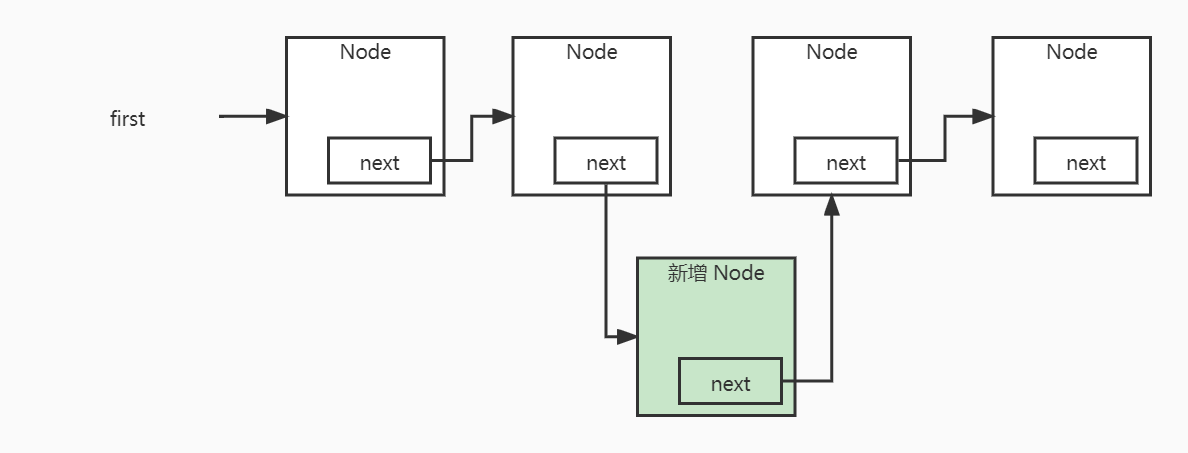引言
由上一篇我们知道,ArrayList的优势是查询速度快,但是插入、删除相对较慢,那对于需要大量增、删操作的数据,该用什么样的结构呢?
链表

如图所示,定义一种链表结构,每一个节点都持有下一个节点的引用,当增加元素时,只需要修改当前位置的指向即可,速度就会比ArrayList复制快。

显然,它有一个弊端,如果我们想获取最后一个元素,必须从第一个元素一个一个查下去,浪费时间。
为了提高查询效率,定义如下结构:

每个元素都持有它前、后两个元素的引用,在遇到上述问题,会大大缩短查询时间。
LinkedList源码
链表首、尾节点的引用:
/**
* Pointer to first node.
* Invariant: (first == null && last == null) ||
* (first.prev == null && first.item != null)
*/
transient Node<E> first;
/**
* Pointer to last node.
* Invariant: (first == null && last == null) ||
* (last.next == null && last.item != null)
*/
transient Node<E> last;
Node结构
private static class Node<E> {
E item;
Node<E> next;// 下一个元素
Node<E> prev;// 上一个元素
Node(Node<E> prev, E element, Node<E> next) {
this.item = element;
this.next = next;
this.prev = prev;
}
}
添加元素 add -> linkLast
public boolean add(E e) {
linkLast(e);
return true;
}
/**
* Links e as last element.
*/
void linkLast(E e) {
// 取尾部元素
final Node<E> l = last;
// 生成新的Node节点
final Node<E> newNode = new Node<>(l, e, null);
// 将尾引用指向新的节点
last = newNode;
if (l == null)// 如果列表中没有元素,将头指向新节点
first = newNode;
else// 如果有元素,将新节点链接到队尾
l.next = newNode;
size++;
modCount++;
}
删除元素 remove -> unlink
public boolean remove(Object o) {
if (o == null) {
// 遍历删除null
for (Node<E> x = first; x != null; x = x.next) {
if (x.item == null) {
unlink(x);
return true;
}
}
} else {
// 遍历找到equals的对象
for (Node<E> x = first; x != null; x = x.next) {
if (o.equals(x.item)) {
unlink(x);
return true;
}
}
}
return false;
}
E unlink(Node<E> x) {
// assert x != null;
// 获取当前节点的前后节点
final E element = x.item;
final Node<E> next = x.next;
final Node<E> prev = x.prev;
// 删除跟上个节点的关系
if (prev == null) {
first = next;
} else {
prev.next = next;
x.prev = null;
}
// 删除跟下个节点的关系
if (next == null) {
last = prev;
} else {
next.prev = prev;
x.next = null;
}
// 删除数据
x.item = null;
size--;
modCount++;
return element;
}
查询数据 get -> node
public E get(int index) {
checkElementIndex(index);
return node(index).item;
}
Node<E> node(int index) {
// assert isElementIndex(index);
// 判断index是否<总个数/2
if (index < (size >> 1)) {
// 正向遍历
Node<E> x = first;
for (int i = 0; i < index; i++)
x = x.next;
return x;
} else {
// 反向遍历
Node<E> x = last;
for (int i = size - 1; i > index; i--)
x = x.prev;
return x;
}
}
其他
LinkedList插入一定比ArrayList快吗?
大家不妨跑跑下面的代码:
public class MyTest {
private static ArrayList<Integer> testArray = new ArrayList<>();
private static LinkedList<Integer> testLinked = new LinkedList<>();
public static void main(String[] args) {
long start = System.currentTimeMillis();
for (int i = 0; i < 10000000; i++) {
testArray.add(i);
}
System.out.println("AAAAA test array time:" + (System.currentTimeMillis() - start));
start = System.currentTimeMillis();
for (int i = 0; i < 10000000; i++) {
testLinked.add(i);
}
System.out.println("AAAAA test linked time:" + (System.currentTimeMillis() - start));
}
}
这是我跑了几次的结果
AAAAA test array time:1233
AAAAA test linked time:2396
AAAAA test array time:833
AAAAA test linked time:2312
AAAAA test array time:824
AAAAA test linked time:2242
于是得出以下结论,在涉及大量数据的增加(直接增加,插入末尾)且很少涉及删除的操作时,ArrayList速度反而更快。
为什么会如此呢?可能与以下代码有关:

LinkedList每次add时,便创建一个Node对象,增大了时间开销。






















 2万+
2万+











 被折叠的 条评论
为什么被折叠?
被折叠的 条评论
为什么被折叠?








